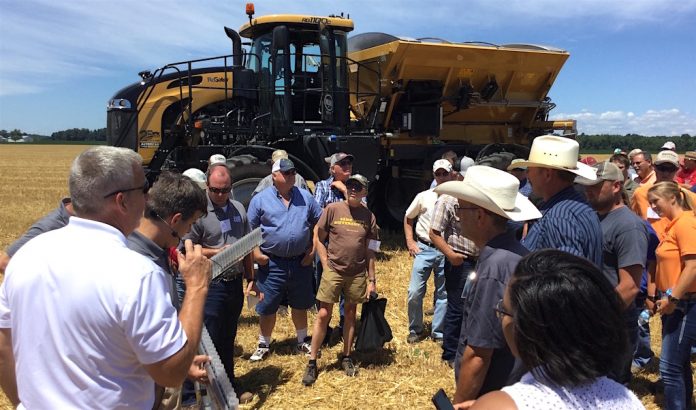
FOREST, Ohio — Farmers and fertilizer applicators learned about the latest in nutrient application technology during the annual 4R Technology Review Day July 17 in Hardin County.
Pressure from the public and the need to use nutrients as efficiently as possible has the industry committing itself to something known as the 4R Stewardship program — using the right rate, time, place and source of nutrients.
To date, about 3 million acres in the western Lake Erie basin have been certified under the 4R program, along with about 50 retailers. The program requires documentation and education between retailers and growers.
Staying current
But the science that surrounds these four rules of handling nutrients is changing, with new ways of applying nutrients and new agronomic research.
Steve Culman, assistant professor in Ohio State University’s School of Environment and Natural Resources, presented the Tri-State Fertilizer Recommendations — a study of plots in Ohio, Michigan and Indiana.
One of the biggest findings was that soils in the maintenance range of fertility showed very little response to additional fertilizer, and that those same soils can often supply nutrients for multiple years, without adding additional fertilizer.
“When soil is in the maintenance range, it has the ability to supply fertility to crops for multiple years,” Culman said.
His findings can help farmers prevent over-application, which not only wastes money, but leaves them more vulnerable to nutrient runoff and water quality issues.
The basic idea of the Tri-State guidelines, he said, has been to build soils up to maintenance levels, and maintain them at crop removal rates. But he said research is also showing that major crops like corn, soybeans and wheat are using less nutrients per bushel of yield.
“In other words, nutrient removal per bushel of grain is less than it was 20 years ago,” Culman said.
Make adjustments
He advised farmers and custom applicators to review his data and make adjustments to their application, based on these principles.
“If you’re above that maintenance range, you’re not having any benefit on your yield, but what you are doing is you’re increasing your environmental risk,” said Lindsay Pease, a research scientist with the U.S. Department of Agriculture’s Agricultural Research Service.
The field day was held at the farm of Bill and Shane Kellogg, one of three farms where research and demonstrations are being done to find better ways of managing nutrients.
Pease is one of several soil scientists who is reviewing edge-of-field runoff from the farms, and trying to find answers to how the nutrients are moving off of farms.
She studies both subsurface and surface drainage, and said that subsurface drainage — field tile — “is not something that we can farm without in this landscape. It’s necessary, so we have to work with it.”
Conservation practice
In fact, Pease said tile drainage can be viewed as a conservation practice, because it helps reduce surface runoff, and thanks to drainage control structures that help slow the flow through tiles — farmers can control how fast water leaves their farm.
“You have to be thinking about both (surface and subsurface) when you manage nutrients on your farm, because ultimately, the nutrients are going to move with the water,” she said.
From what she has seen, she said the 4Rs are “directionally correct” for reducing phosphorus loading, and she expects that to show in the research.
One of the things her team recently experimented with was a phosphorus removal filter, made from steel slag material that researchers used to filter out phosphorus before it entered the waterway. The material worked well, but researchers found they needed to crush the slag into smaller particles, to be more efficient.
Pease said it was a good experiment, and one of the many ways researchers and farmers are working to try and find solutions.
“It’s a complicated problem,” she said. “If it was easy, we’d already have it solved. I really think the solutions are there and following these principles, the 4R principles, you can actually go a long way toward reducing your losses.”
Farmers hope that will be the case, especially the three who opened their farms to on-farm research. During a panel discussion, each farmer talked about the practices they’re most likely to continue using, and what they see ahead in the area of nutrient management.
Duane Stateler, a swine and crop producer from McComb, said he sees a lot of value in water control structures and water gates, which give him some options for retaining water and slowing discharge.
Bill Kellogg, who crop farms about 5,000 acres, said cover crops are working well, along with subsurface placement of nutrients. He recently invested in a piece of machinery that strip tills and applies fertilizer below ground with the same pass.
What’s missing?
As to what the farmers would like to have more of, Chris Kurt, a crop farmer from Dunkirk, said he’d like to have more research and field testing.
“I know it’s expensive, but I think it’s going to help us solve the problem,” he said.
One of the tools farmers now have is On-Field Ohio — an online tool that helps farmers track their erosion and phosphorus loss risk, based on different crop management scenarios. The tool takes into account such factors as slope, soil type, crop and tillage method, and gives numerical values for anticipated P loss on the surface and through the tile.
During the afternoon, the group got to see some of the newest in fertilizer application equipment, including a broadcast spreader by New Leader, which relies on a technology called “swath width control.”
The spreader is configured so that the spinner fan frame can move forward and back, and side to side, allowing the unit to shut off and turn on in sections, mimicking the pattern of a boom spreader.
The field day was held by the Ohio AgriBusiness Association, a sponsor of the 4R program in Ohio.









